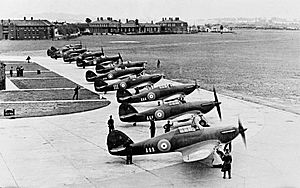Stanley Connors facts for kids
Quick facts for kids
Stanley Connors
|
|
|---|---|
| Born | 8 April 1912 Calcutta, British India (now India) |
| Died | 18 August 1940 (aged 28) Wallington, Surrey, United Kingdom |
| Buried |
North Berwick Cemetery, United Kingdom
|
| Allegiance | United Kingdom |
| Service/ |
Royal Air Force |
| Years of service | 1937–1940 |
| Rank | Flight Lieutenant |
| Unit | No. 111 Squadron |
| Battles/wars | Second World War |
| Awards | Distinguished Flying Cross & Bar |
Stanley Connors (born April 8, 1912 – died August 18, 1940) was a brave British pilot. He was a flying ace who flew for the Royal Air Force (RAF) during World War II. He was known for shooting down at least twelve enemy aircraft.
Stanley was born in Calcutta, which was then part of British India. He joined the RAF in 1937. Before that, he had served in other parts of the RAF. In June 1938, he joined No. 111 Squadron. He flew Hawker Hurricane fighter planes. During the Battle of France, he shot down six German planes in just two days. For his bravery, he received the Distinguished Flying Cross.
Contents
Early Life and Joining the RAF
Stanley Dudley Pierce Connors was born in Calcutta, British India, on April 8, 1912. His parents were Pierce and Norah Connors. He went to school in Darjeeling at St Paul's School. Later, his family moved to England, where they had a home.
Stanley was nicknamed 'Conny'. He first joined a special part of the Royal Air Force (RAF) in 1936. He became a pilot officer. Soon after, he joined the Royal Auxiliary Air Force (RAuxAF). This was a new group formed from the Special Reserve. He joined No. 500 Squadron as a pilot officer. This squadron flew light bomber planes from Manston.
In December 1937, Stanley officially joined the RAF. He went to No. 5 Flying Training School to learn more. After earning his pilot's wings, he was sent to No. 111 Squadron in June 1938. At that time, the squadron was based at Northolt. They flew the fast Hawker Hurricane fighter planes. Stanley was confirmed as a pilot officer later that year.
Fighting in World War II
Soon after World War II began, No. 111 Squadron moved north. They went to Acklington and then to Drem in Scotland. From there, they flew patrols along the coast. In February 1940, the squadron moved again to Wick. They protected the Royal Navy base at Scapa Flow from air attacks.
By May 1940, the squadron was back in southern England. From there, they often flew to France. This was after Germany had invaded France. Stanley had been promoted to flying officer in August 1939. He got his first air victories on May 18, 1940. He shot down a German Messerschmitt Bf 109 fighter. Then he destroyed a Junkers Ju 88 medium bomber. The next day, he shot down three Heinkel He 111 bombers and another Ju 88. Because of his success, Stanley received the Distinguished Flying Cross.
At the end of May and early June, No. 111 Squadron helped with Operation Dynamo. This was when British soldiers were evacuated from Dunkirk. By this time, Stanley was a flight lieutenant. He led one of the squadron's groups of planes. On May 31, he destroyed a Bf 109 over Dunkirk. On June 2, he claimed to have shot down a He 111, also over Dunkirk. After the evacuation, the squadron protected British bombers. These bombers attacked targets along the French coast. On June 7, Stanley destroyed another Bf 109 west of Abbeville.
The Battle of Britain
After a break to train new pilots, No. 111 Squadron moved to Croydon. They began patrolling over the English Channel. Soon, they were fighting in the Battle of Britain. This was a big air battle over southeast England. On July 19, Stanley shot down a Bf 109 near Folkestone. He damaged another one near Dover on July 25.
On July 31, he helped destroy a Ju 88 over the English Channel. On August 11, he shot down a Bf 109 near Margate. Four days later, he flew several missions. He shot down a Ju 88 and damaged another near Selsey Bill. He also destroyed a Messerschmitt Bf 110 heavy fighter and damaged a second. These fights happened near Redhill and Croydon. On August 16, he damaged a Dornier Do 17 medium bomber near Maidstone.
Stanley Connors' Final Flight
August 18, 1940, was known as the Hardest Day. On this day, No. 111 Squadron was sent to protect the airfield at Kenley. A large German air force (Luftwaffe) bombing raid was targeting it. While attacking a Do 17, Stanley's plane was hit by anti-aircraft fire. His Hurricane plane caught fire. But a witness saw Stanley keep attacking the Do 17. He managed to shoot it down.
His burning Hurricane then crashed at Wallington. Stanley was thrown from the plane and died. Soon after his death, it was announced that he would receive another award. This was a Bar to his Distinguished Flying Cross. This meant he had earned the DFC twice.
Stanley Connors was survived by his wife, Marjorie. He was buried in North Berwick Cemetery. By the time he died, Stanley was credited with shooting down twelve German aircraft. He also had two other victories that were not fully confirmed. He also helped shoot down one other plane that was not confirmed. In addition, he was credited with damaging four enemy aircraft.


